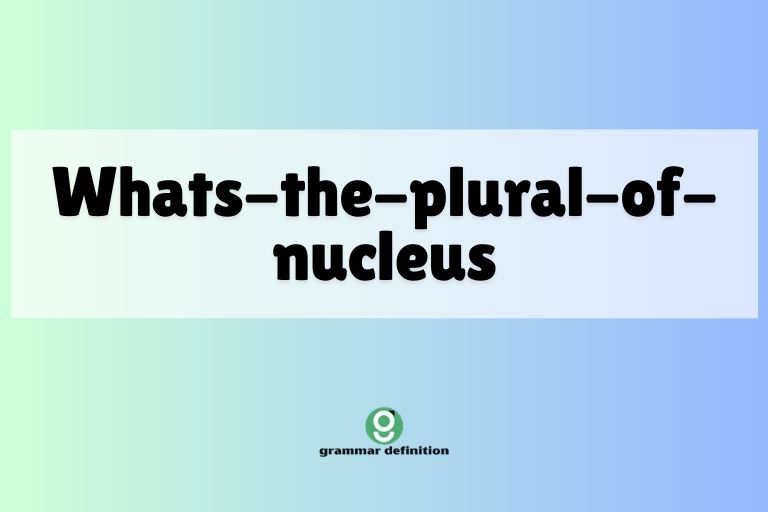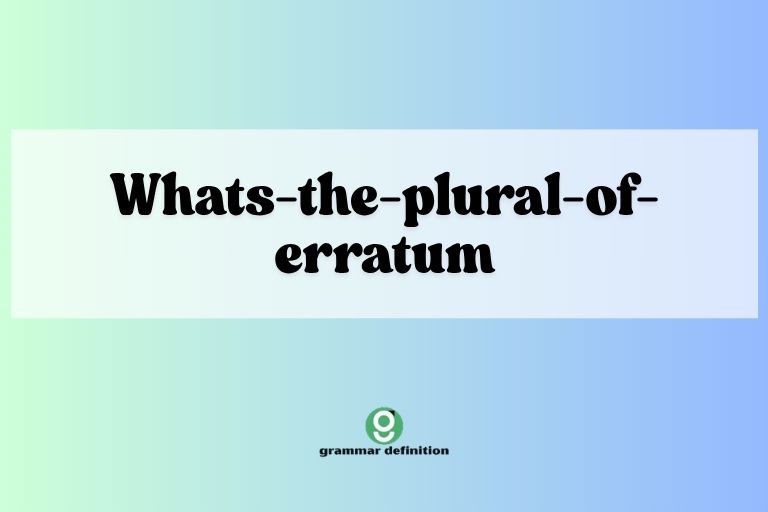Nucleus Plural: Mastering the Correct Forms and Usage

Understanding the plural form of “nucleus” is crucial for anyone working with scientific, technical, or even advanced general English. The word, primarily used in biology, physics, and chemistry, refers to the central part of an atom or cell.
Knowing whether to use “nuclei” or “nucleuses” and when is essential for clear and accurate communication. This article provides a comprehensive guide to the pluralization of “nucleus,” covering definitions, structural rules, usage guidelines, common mistakes, and practice exercises.
It will benefit students, researchers, writers, and anyone seeking to improve their grasp of English grammar in specialized contexts.
This guide will walk you through everything you need to know, from the basic definition to advanced usage scenarios. We will explore the correct plural forms, delve into their origins, and provide ample examples to solidify your understanding.
By the end of this article, you’ll be confident in using the correct plural form of “nucleus” in any situation.
Table of Contents
- Definition of Nucleus
- Structural Breakdown: Singular vs. Plural
- Types and Categories of Nuclei
- Examples of Nucleus and Nuclei in Sentences
- Usage Rules: When to Use Nuclei vs. Nucleuses
- Common Mistakes in Pluralizing Nucleus
- Practice Exercises
- Advanced Topics: Etymology and Historical Usage
- Frequently Asked Questions
- Conclusion
Definition of Nucleus
The word “nucleus” has several related meanings, all revolving around the concept of a central point or core. In general terms, a nucleus is the central or essential part of anything around which other parts are gathered or grouped.
However, its most common usage is in the sciences, particularly biology, physics, and chemistry.
Biological Definition: In biology, the nucleus is a membrane-bound organelle found in eukaryotic cells. It contains the cell’s genetic material in the form of DNA, organized into chromosomes. The nucleus controls and regulates cell activities, including growth, metabolism, and reproduction. It directs protein synthesis and ensures the proper functioning of the cell.
Physical Definition: In physics, the nucleus refers to the positively charged central core of an atom. It consists of protons and neutrons (except in the case of hydrogen-1, which has only one proton). The nucleus contains most of the atom’s mass and is responsible for the atom’s identity and chemical properties.
General Definition: More broadly, “nucleus” can refer to any central or core element of a system, organization, or idea. For example, the nucleus of a political party might be its core group of leaders, or the nucleus of a story might be its central theme.
Structural Breakdown: Singular vs. Plural
The structural change from singular to plural for “nucleus” is a classic example of irregular pluralization in English, stemming from its Latin origins. Understanding this shift is key to using the word correctly.
Singular Form: Nucleus
The singular form, “nucleus,” refers to a single instance of the central core. The word ends in “-us,” a common ending for Latin nouns.
Plural Form: Nuclei
The primary plural form of “nucleus” is “nuclei.” This pluralization follows the Latin rule of changing the “-us” ending to “-i.” This is the most widely accepted and grammatically correct plural form, especially in scientific and formal contexts.
Alternative Plural Form: Nucleuses
While “nuclei” is the preferred plural, “nucleuses” is also sometimes used, particularly in less formal contexts. This pluralization follows the standard English rule of adding “-es” to the end of the singular noun.
However, it is generally considered less elegant and less precise than “nuclei,” especially in scientific writing.
Types and Categories of Nuclei
The term “nucleus” is used across different scientific disciplines, and understanding these contexts can help clarify its meaning and usage.
Biological Nuclei
Biological nuclei are found in eukaryotic cells. They contain the cell’s DNA and control its activities.
Different types of cells have different types of nuclei, depending on their function and stage of development. For example, the nuclei of nerve cells are different from those of muscle cells.
Atomic Nuclei
Atomic nuclei are the central cores of atoms, consisting of protons and neutrons. Different elements have different numbers of protons in their nuclei, defining their atomic number and chemical properties.
Isotopes of the same element have the same number of protons but different numbers of neutrons in their nuclei.
Figurative Nuclei
In a figurative sense, “nucleus” can refer to the central or core element of a concept, organization, or system. This usage extends beyond scientific contexts and applies to various fields, such as politics, literature, and social sciences.
Examples of Nucleus and Nuclei in Sentences
To illustrate the correct usage of “nucleus” and “nuclei,” here are several examples categorized by context.
Biological Context
The following table provides examples of “nucleus” and “nuclei” used in biological contexts. These sentences demonstrate how the terms are used in scientific writing and discussions about cell biology.
| Singular (Nucleus) | Plural (Nuclei) |
|---|---|
| The nucleus of the cell contains the DNA. | The nuclei of the cells were stained for better visibility. |
| The nucleus is responsible for controlling cell growth. | Multiple nuclei can be found in some fungal cells. |
| The structure of the nucleus is complex and well-organized. | The arrangement of nuclei in the tissue sample was abnormal. |
| The nucleus directs the synthesis of proteins within the cell. | These nuclei are essential for the replication process. |
| The nucleus is surrounded by a nuclear envelope. | The researchers examined the nuclei under a microscope. |
| The nucleus is the control center of the cell. | The presence of multiple nuclei indicates a specific condition. |
| A single nucleus is typical for most eukaryotic cells. | The nuclei of the cancer cells appeared enlarged. |
| The nucleus contains the cell’s chromosomes. | The nuclei were isolated from the cell lysate. |
| The nucleus plays a critical role in cell division. | The nuclei are involved in gene transcription. |
| The nucleus is essential for the survival of the cell. | The nuclei of these cells are actively dividing. |
| The nucleus regulates gene expression. | The study focused on the behavior of nuclei during mitosis. |
| The nucleus is a key component of eukaryotic cells. | The nuclei showed signs of damage. |
| The nucleus houses the nucleolus. | The nuclei were genetically modified in the experiment. |
| The nucleus dictates the cell’s function. | The nuclei are distributed evenly throughout the tissue. |
| The nucleus is protected by a double membrane. | The nuclei of these cells contain different numbers of chromosomes. |
| The nucleus is actively involved in cell signaling. | The nuclei were analyzed using flow cytometry. |
| The nucleus coordinates cellular processes. | The nuclei are critical for proper cell function. |
| The nucleus is a vital part of the cell structure. | The nuclei were observed to be moving within the cell. |
| The nucleus is the site of RNA synthesis. | The nuclei are stained with a fluorescent dye. |
| The health of the nucleus determines the health of the cell. | Healthy nuclei are essential for tissue homeostasis. |
| The nucleus‘s size can vary depending on the cell type. | The size of the nuclei varied across different cell types. |
| The nucleus is a target for many drugs. | The nuclei were affected by the drug treatment. |
Physical Context
This table illustrates the use of “nucleus” and “nuclei” in physics, particularly in discussions about atomic structure and nuclear reactions.
| Singular (Nucleus) | Plural (Nuclei) |
|---|---|
| The nucleus of an atom contains protons and neutrons. | The nuclei of heavy atoms are less stable. |
| The nucleus is positively charged. | These nuclei are involved in nuclear fusion. |
| The structure of the nucleus determines the element’s identity. | The arrangement of nuclei in a crystal lattice affects its properties. |
| The nucleus is held together by the strong nuclear force. | The nuclei of isotopes have different numbers of neutrons. |
| The nucleus is much smaller than the atom itself. | The researchers studied the properties of different nuclei. |
| The nucleus is the site of nuclear reactions. | The nuclei are accelerated in a particle accelerator. |
| The nucleus can undergo radioactive decay. | The nuclei emitted alpha particles during the decay process. |
| The nucleus of hydrogen has only one proton. | The nuclei of helium have two protons and two neutrons. |
| The nucleus is essential for the atom’s stability. | The nuclei of uranium are used in nuclear reactors. |
| The nucleus accounts for most of the atom’s mass. | The nuclei are bombarded with neutrons to induce fission. |
| The nucleus is a dense and compact structure. | The nuclei of atoms are quantized with specific energy levels. |
| The nucleus‘s composition determines its stability. | The stability of nuclei depends on the neutron-to-proton ratio. |
| The nucleus is studied using nuclear physics. | The study of nuclei helps us understand the fundamental forces of nature. |
| The nucleus can be split in a nuclear fission reaction. | The nuclei split during nuclear fission release a large amount of energy. |
| The nucleus is a source of energy in nuclear power plants. | The nuclei in the reactor are carefully controlled to prevent a meltdown. |
| The nucleus‘s magnetic moment can be measured. | The magnetic moments of nuclei are used in MRI technology. |
| The nucleus can absorb or emit photons. | The nuclei emit gamma rays during certain nuclear transitions. |
| The nucleus is surrounded by electrons. | The interaction between nuclei and electrons determines chemical bonding. |
| The nucleus is shielded by the electron cloud. | The electron clouds shield the nuclei from external forces. |
| The nucleus‘s properties are crucial for understanding matter. | The properties of nuclei are fundamental to nuclear science. |
Figurative Context
This table provides examples of “nucleus” and “nuclei” used in a figurative sense, referring to the central or core element of a concept, organization, or system.
| Singular (Nucleus) | Plural (Nuclei) |
|---|---|
| The nucleus of the argument was the need for reform. | The nuclei of these ideas formed the basis of the new policy. |
| The nucleus of the team was the experienced players. | The nuclei of the different factions within the organization clashed. |
| The nucleus of the city’s economy is its financial district. | The nuclei of innovation are often found in universities and research institutions. |
| The nucleus of the problem was a lack of communication. | The nuclei of the conflict were deeply rooted in historical grievances. |
| The nucleus of the plan was to increase efficiency. | The nuclei of the project were the key milestones that needed to be achieved. |
| The nucleus of the company’s success was its dedicated employees. | The nuclei of the company’s different departments worked together to achieve its goals. |
| The nucleus of the community was the local church. | The nuclei of the neighborhood were the families that had lived there for generations. |
| The nucleus of the debate was the issue of funding. | The nuclei of the discussion were the different perspectives on the problem. |
| The nucleus of the novel was the theme of redemption. | The nuclei of the story were the main characters and their relationships. |
| The nucleus of the movement was the group of activists. | The nuclei of the protest were the demands for social justice. |
| The nucleus of the project was the research phase. | The nuclei of the experiment were the control and experimental groups. |
| The nucleus of the strategy was to target new markets. | The nuclei of the marketing campaign were the key messages that needed to be communicated. |
| The nucleus of the negotiation was the price. | The nuclei of the agreement were the terms and conditions that were acceptable to both parties. |
| The nucleus of the organization was its leadership. | The nuclei of the structure were the different departments and divisions. |
| The nucleus of the system was the central server. | The nuclei of the network were the routers and switches that connected the different devices. |
| The nucleus of the partnership was the shared vision. | The nuclei of the collaboration were the resources and expertise that each partner brought to the table. |
| The nucleus of the solution was a compromise. | The nuclei of the resolution were the steps that needed to be taken to address the problem. |
| The nucleus of the reform was the new law. | The nuclei of the policy were the regulations and guidelines that were put in place. |
| The nucleus of the innovation was the new technology. | The nuclei of the invention were the different components and features that made it unique. |
Usage Rules: When to Use Nuclei vs. Nucleuses
Deciding between “nuclei” and “nucleuses” depends on the context and level of formality. Here’s a breakdown:
Formal and Scientific Contexts
In scientific writing, academic papers, and formal reports, “nuclei” is the preferred and most accurate plural form. It reflects the word’s Latin origin and is considered the standard in these fields. Using “nuclei” demonstrates precision and adherence to established scientific conventions.
Informal Contexts
In less formal settings, such as casual conversations or general-interest articles, “nucleuses” may be acceptable. However, it is still less common and can sound awkward to some. Even in informal contexts, “nuclei” is generally a safer and more widely understood choice.
Consistency
Regardless of the context, maintaining consistency is crucial. If you choose to use “nuclei,” use it throughout your document or presentation.
Similarly, if you opt for “nucleuses” (though less recommended), stick with it consistently. Mixing the two forms can create confusion and detract from the clarity of your writing.
Common Mistakes in Pluralizing Nucleus
Several common mistakes arise when pluralizing “nucleus.” Recognizing and avoiding these errors can improve the accuracy of your writing.
Incorrect Pluralization
One common mistake is using “nuclei” as a singular form. Remember that “nuclei” is always plural.
Another error is using “nucleus’s” as a plural, which incorrectly implies possession.
Mixing Singular and Plural Forms
Inconsistent usage of singular and plural forms can lead to confusion. For example, writing “The nucleus are important” is grammatically incorrect because the singular subject “nucleus” does not agree with the plural verb “are.”
Overgeneralization of Pluralization Rules
Applying standard English pluralization rules to “nucleus” can also result in errors. While “nucleuses” is sometimes used, it is generally less preferred than “nuclei,” especially in formal and scientific contexts.
Avoid creating non-standard plural forms like “nuclei’s.”
Here is a table showing some common mistakes:
| Incorrect | Correct | Explanation |
|---|---|---|
| The nuclei is important. | The nucleus is important. | “Nuclei” is plural; use “nucleus” for singular. |
| The nucleus are important. | The nuclei are important. | “Nucleus” is singular; use “nuclei” for plural. Subject-verb agreement. |
| Nucleus’s | Nuclei | “Nucleus’s” implies possession, not pluralization. |
| The nucleis | The nuclei | Incorrect plural form. |
Practice Exercises
Test your understanding of the pluralization of “nucleus” with these exercises. Fill in the blanks with the correct form (nucleus or nuclei).
Exercise 1: Fill in the Blanks
Complete the following sentences with the correct form of “nucleus” (singular or plural).
- The _________ of the cell contains DNA.
- The scientist studied the _________ under a microscope.
- Multiple _________ were observed in the sample.
- Each _________ is responsible for controlling cell growth.
- The _________ is a key component of eukaryotic cells.
- The _________ in the sample appeared enlarged.
- The _________ of the atom contains protons and neutrons.
- The _________ are essential for cell division.
- The _________ regulates the activity of the cell.
- The _________ of the argument was the need for reform.
Answer Key:
- nucleus
- nuclei
- nuclei
- nucleus
- nucleus
- nuclei
- nucleus
- nuclei
- nucleus
- nucleus
Exercise 2: Correct the Sentences
Identify and correct the errors in the following sentences related to the pluralization of “nucleus.”
- The nuclei is responsible for cell growth.
- The nucleus are stained for better visibility.
- Each cells has a nucleus.
- The nucleus’s were analyzed.
- The nucleis of the atoms were studied.
- The nucleus are important for cell function.
- The nuclei is surrounded by a membrane.
- The nucleus’s contain DNA.
- The scientist studied the nucleus under the microscope.
- These cell’s nuclei are visible.
Answer Key:
- The nucleus is responsible for cell growth.
- The nuclei are stained for better visibility.
- Each cell has a nucleus.
- The nuclei were analyzed.
- The nuclei of the atoms were studied.
- The nuclei are important for cell function.
- The nucleus is surrounded by a membrane.
- The nuclei contain DNA.
- The scientists studied the nuclei under the microscope.
- These cells’ nuclei are visible.
Exercise 3: Choose the Correct Form
Select the correct form of “nucleus” (singular or plural) to complete each sentence.
| Question | Option A | Option B | Answer |
|---|---|---|---|
| The _________ of the atom is positively charged. | nucleus | nuclei | nucleus |
| The scientist examined the _________ of the cells. | nucleus | nuclei | nuclei |
| Multiple _________ were found in the tissue sample. | nucleus | nuclei | nuclei |
| Each _________ plays a vital role in cell function. | nucleus | nuclei | nucleus |
| The _________ contains the genetic material. | nucleus | nuclei | nucleus |
| The _________ in the sample appeared abnormal. | nucleus | nuclei | nuclei |
| The _________ of hydrogen has only one proton. | nucleus | nuclei | nucleus |
| The _________ are involved in cell division. | nucleus | nuclei | nuclei |
| The _________ regulates gene expression. | nucleus | nuclei | nucleus |
| The _________ of the debate was the issue of funding. | nucleus | nuclei | nucleus |
Advanced Topics: Etymology and Historical Usage
Delving into the etymology and historical usage of “nucleus” provides a deeper appreciation for its meaning and evolution.
Etymology
The word “nucleus” comes from the Latin word nucleus, which means “kernel” or “nut.” This term is derived from nux, meaning “nut.” The association with a kernel or nut reflects the idea of a central, essential part contained within a larger structure.
Historical Usage
The term “nucleus” has been used in English since the 18th century, initially in a general sense to refer to the central part of anything. Its scientific usage, particularly in biology and physics, became more prominent in the 19th and 20th centuries as these fields advanced.
The pluralization “nuclei” has been the standard in scientific contexts since then, reflecting the influence of Latin grammar in scientific terminology.
Frequently Asked Questions
Here are some frequently asked questions about the pluralization of “nucleus.”
- Is “nucleuses” an acceptable plural form?
While “nucleuses” is sometimes used, it is generally considered less formal and less precise than “nuclei.” In scientific and academic contexts, “nuclei” is the preferred and more accurate plural form.
- Why is “nuclei” the preferred plural form?
“Nuclei” follows the Latin rule of changing the “-us” ending to “-i” to form the plural. This is the standard pluralization for many Latin-derived nouns in English, especially in scientific terminology.
- Can I use “nucleuses” in informal writing?
In informal contexts, “nucleuses” may be acceptable, but it is still less common and can sound awkward to some. It’s generally safer to use “nuclei,” even in informal settings.
- How do I remember the correct plural form?
Think of other Latin-derived words that follow the same pluralization rule, such as “radius” (plural: radii) or “stimulus” (plural: stimuli). This can help you remember that “nucleus” becomes “nuclei” in the plural.
- What is the difference between “nucleus” and “nuclei”?
“Nucleus” is the singular form, referring to one central core or element. “Nuclei” is the plural form, referring to multiple central cores or elements.
- Is it ever correct to use “nucleus’s”?
No, “nucleus’s” is incorrect as a plural form. It implies possession by a single nucleus. The correct plural form is “nuclei.”
- What if I’m unsure which form to use?
When in doubt, use “nuclei.” It is the more widely accepted and grammatically correct plural form, especially in formal and scientific writing.
- Does the context change the pluralization rule?
The context primarily affects the level of formality. In scientific and academic contexts, “nuclei” is always preferred. In informal contexts, “nucleuses” may be used, but “nuclei” is still a safe and widely understood choice.
Conclusion
Mastering the pluralization of “nucleus” is essential for accurate and effective communication, especially in scientific and technical fields. While “nucleuses” is sometimes used in informal contexts, “nuclei” remains the preferred and grammatically correct plural form.
Understanding the Latin origins of the word and its usage across different disciplines can further enhance your grasp of this important grammar point.
By following the guidelines and examples provided in this article, you can confidently use “nucleus” and “nuclei” in your writing and speaking. Remember to maintain consistency in your usage and to prioritize “nuclei” in formal and scientific settings.
With practice and attention to detail, you can avoid common mistakes and communicate with clarity and precision. Keep practicing, and you’ll master this tricky plural in no time!






